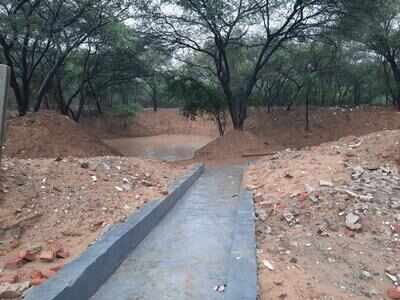- News
- City News
- gurgaon News
- Can pits help in other areas too? MCG to survey
Can pits help in other areas too? MCG to survey

Gurgaon: The Municipal Corporation of Gurgaon (MCG) is exploring the option of building small ponds, pits or creeks in flood-prone areas. The decision was taken at a meeting chaired by mayor Madhu Azad, where officials pointed out how drains and natural creeks had helped Golf Course Road stay dry when other parts of the city were under ankle-deep water on Monday.
Urban planning experts backed the decision, but insisted that Gurgaon should adopt a multi-pronged approach to tackle flooding during monsoon.
“This is a good decision. But the dimensions of a pond should be calculated keeping in mind the maximum capacity of rain. They should either increase the capacity of a pond or a pit or build many of them. The infrastructure should be such that water is channelised to a pond or pit and is not pumped back into the drain,” said Sewa Ram, a professor of transport planning at the School of Planning and Architecture, Delhi.
He added that an alternative approach should be to retain water at the top. In underpasses and areas where these pits can’t be made, retaining water at the top and then diverting it through drains and creeks would help — an approach that helped Golf Course Road stay dry on Monday.
Mukta Naik, an urban planning expert and a fellow at the Centre for Policy Research, agreed that the restoration of the natural drainage system in the Aravalis had helped prevent waterlogging on Golf Course Road.
“Creating small pits or ponds and restoring the natural creeks is a no-harm principle. But we will have to look for engineering solutions in areas where these cannot be implemented to divert extra water. However, making these recharge zones will be feasible only in natural low-lying areas, which are available,” Naik said.
MCG had in June identified 80 areas across the city that are prone to waterlogging. Asked if it was feasible to make such structures in all flood-prone areas, the experts said interventions need not come up on the site itself. “For example, if you want to tackle waterlogging at Rajiv Chowk, you will have to intervene from Ghata and Badshahpur all the way down so that the runoff does not reach Rajiv Chowk. We have to have a multi-pronged approach,” Naik said.
Urban planning experts backed the decision, but insisted that Gurgaon should adopt a multi-pronged approach to tackle flooding during monsoon.
“This is a good decision. But the dimensions of a pond should be calculated keeping in mind the maximum capacity of rain. They should either increase the capacity of a pond or a pit or build many of them. The infrastructure should be such that water is channelised to a pond or pit and is not pumped back into the drain,” said Sewa Ram, a professor of transport planning at the School of Planning and Architecture, Delhi.
He added that an alternative approach should be to retain water at the top. In underpasses and areas where these pits can’t be made, retaining water at the top and then diverting it through drains and creeks would help — an approach that helped Golf Course Road stay dry on Monday.
Mukta Naik, an urban planning expert and a fellow at the Centre for Policy Research, agreed that the restoration of the natural drainage system in the Aravalis had helped prevent waterlogging on Golf Course Road.
“Creating small pits or ponds and restoring the natural creeks is a no-harm principle. But we will have to look for engineering solutions in areas where these cannot be implemented to divert extra water. However, making these recharge zones will be feasible only in natural low-lying areas, which are available,” Naik said.
MCG had in June identified 80 areas across the city that are prone to waterlogging. Asked if it was feasible to make such structures in all flood-prone areas, the experts said interventions need not come up on the site itself. “For example, if you want to tackle waterlogging at Rajiv Chowk, you will have to intervene from Ghata and Badshahpur all the way down so that the runoff does not reach Rajiv Chowk. We have to have a multi-pronged approach,” Naik said.
FacebookTwitterLinkedinEMail
Start a Conversation
end of article
Quick Links
Delhi Air PollutionDelhi TemperatureChennai WeatherBangalore TemperatureCovid vaccination centres in DelhiCoronavirus in DelhiRTPCR test in GurgaonHyderabad RainPollution level in BangaloreDelhi SmogDelhi TemperatureNoida AQIGurgaon AQI todayFire in MumbaiMumbai RainsCovid 19 RT PCR Test in NoidaDelhi AQI todaySrinagar encounter
